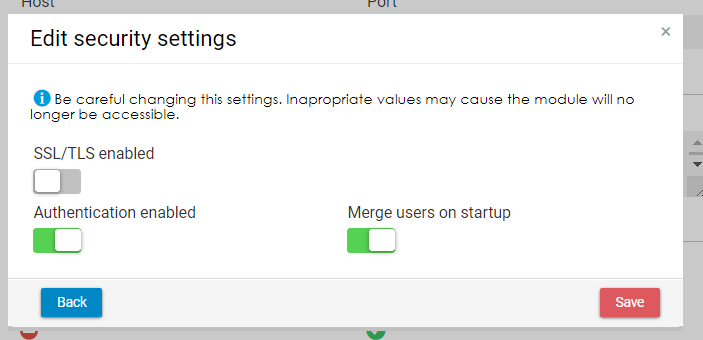The Configuration page is used to display and manage the basic configuration of the sender. It is divided into three boxes: Configuration, Status, and Data source.
Configuration
The first box contains information about the sender, its database, and security.
Basic
Basic configuration is used to display and change the metadata of the module - the name and the description.
Common
In the common configuration, users can see the type of the module, its ID, host and port where the module is running. They can change the port by clicking on Edit. After applying the changes, the module will be started on the selected port. Please note that this port has to be available - not occupied by other module or another service, and opened in the firewall.
The port can be changed by domain administrator and IoT administrator in single-domain environment, and by domain administrator who is also global administrator in multi-domain environment.
For more information about each option, please see this page.
License
Administrators can edit the license key directly from the IoT Console.
Security settings
Additionally, administrators can change the security settings:
- Enable or disable authentication
- Enable or disable SSL/TLS
- Enable or disable merging of users on startup
This functionality is available to domain administrator and IoT administrator in single-domain environment, and to domain administrator who is also global administrator in multi-domain environment.
After enabling SSL/TLS via the IoT Console, it is necessary to create a new keystore, or modify the default keystore.js, and add the certificate. This has to be done to all modules where the SSL/TLS is enabled. You can learn more about adding SSL/TLS here.
Status
The Status box displays the status of the sender.
The button Reload is used to reload the sender after changes. The button Pause is used to temporarily suspend the sender. When paused, the sender won't process any new data. After clicking on Resume, the sender will start working again.
The date and time of the last update can be found at the bottom of this box.
Data Source
In this box, the user can select which receiver will be associated with this sender.
The data source is defined by a set of parameters.
| Parameter | Description |
|---|---|
| Receiver | Drop-down list with all available receivers. |
| Period | Delay (in seconds) after which the timer will fire new send event. |
| Limit | The maximum amount of records which will be loaded from the receiver in batch. |
| Input mode | Single or Bulk. For Single, each message contains exactly one set (row) of data. For Bulk, the message can contain more sets (rows). The input mode has to be the same for both receiver and sender. |
| Path to data element | Specifies "data" element path in BULK mode. Default value is "data". Example: root.data (for XML) |
| Delete Processed | Flag indicating if processed data should be deleted from the receiver database. |
Notification settings
When a sender is unable to send data within 6*Period time, it will send a predefined email. Visit page Actions and Rules and section Send email with the details on how to configure the email server settings.





